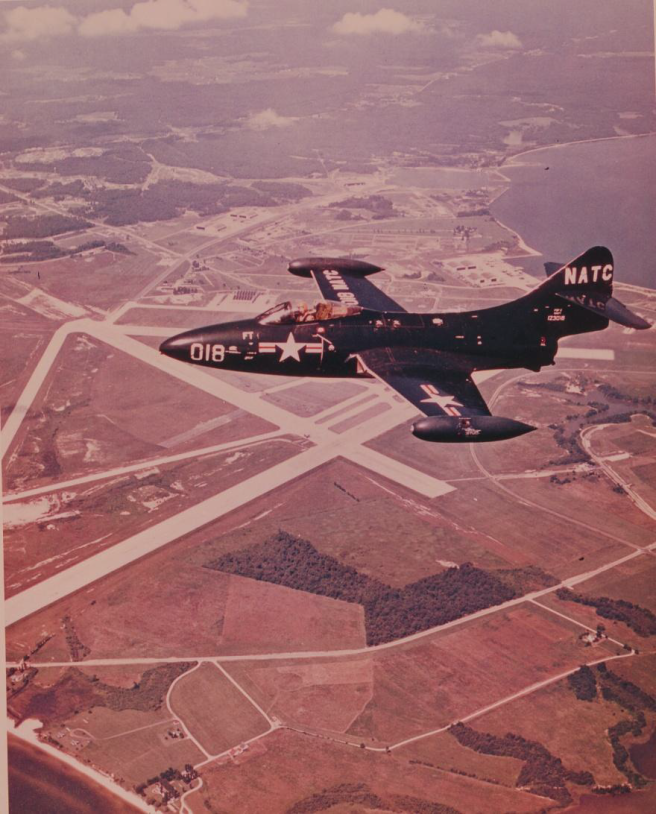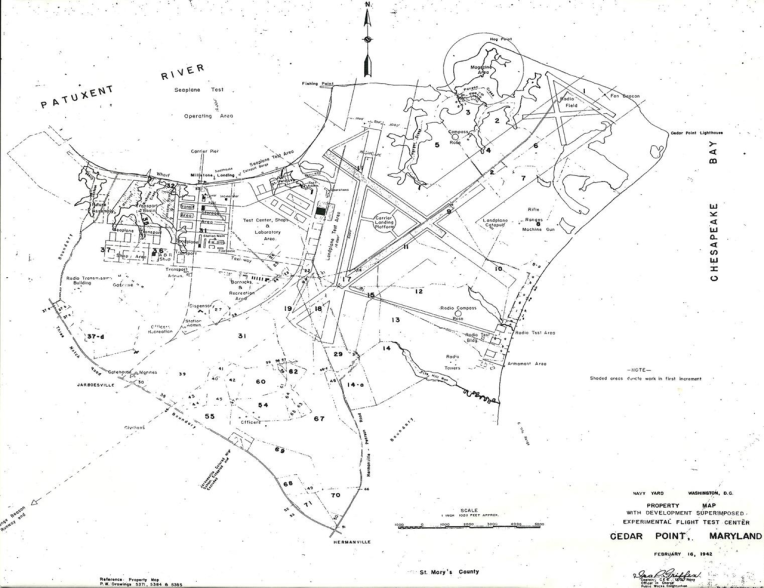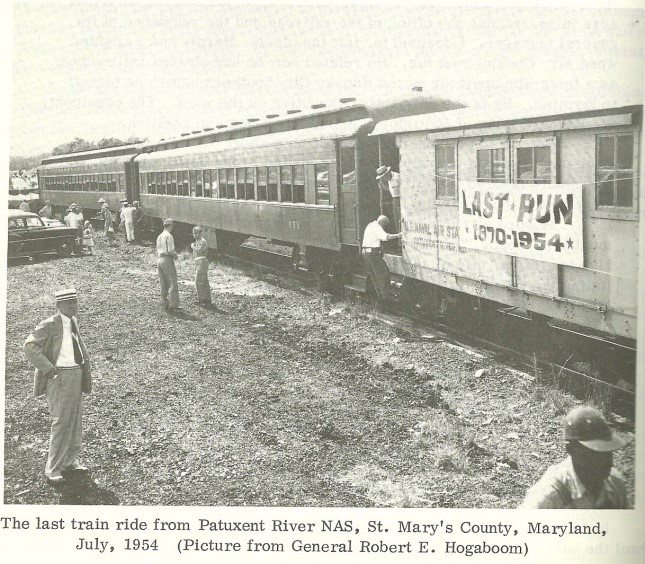by Dan Dickey
NAS CONSTRUCTION AND PROBLEMS
As covered in Segment 4, the Cedar Point land had been ceded to the government through eminent domain and the residents were officially given about 30 days to vacate their properties by April 1, 1942. The contract to start construction of the Experimental Flight Test Center was issued in February 9, 1942 and with that came the first increment of funding of $6 million dollars out of a projected $42 million cost to build the NAS. The money would be divided between General Flight Test Area, the Armament Test Area, and the Naval Transport Service Area. The contract consisted of 3 pages. The initial layout of the Experimental Flight Test Center showing the air field and the layout of the runways was approved in February 16, 1942.
Ground was broken in April 4, 1942. Many of the tenant farmers and landowners saw this as a great deal to get a job building the base. Employment at first was at 650 persons, within 6 months employment grew to 3,000 workers, and reached a peak of about 7,000 workers in 9 months. This had a tremendous impact on St. Mary’s County. [1] The types of jobs they were doing included landscaping, building roads and structures, and laying concrete and managing the effort. This project brought in people from across the nation looking to pick up jobs at high wages. This high influx of people caused lots of problems with housing, food, and transportation.
HOUSING AND FOOD
The Navy was not prepared for this great influx of people wanting a job. It didn’t take long for the hotels in Jarboesville (just outside the gate) and Leonardtown to fill up. “No Vacancy” signs were all over. People were parked on the side of the road. Persons with trailers were finding it hard to find places to park. People were sleeping under the stars on the green in Leonardtown, and neighborly folks were accepting workers into their homes. The Millison Plaza was a trailer park for base workers.
The Navy responded by erecting 35 barracks on base each to accommodate 95 military workers, but these weren’t enough. The Navy continued to build up Jarboesville by creating streets with names that related to locations of the World War II naval battles (Lei, Coral, Salamaua, and Tulag to name a few) as reminders of our presence in the South Pacific. The Navy renamed the town to Lexington Park after the USS Lexington (CV2) WWII aircraft carrier that was lost during the battle of Coral Sea.
[1] History St. Mary’s County – Regina Hammett Page 411
Experimental Flight Test Center at Cedar Point, Maryland (February 16, 1942)
In addition, the Navy let contracts to build in several areas around Lexington Park:
- The “Flat Tops” numbering 150 family 2 family duplexes just outside the gate. These family buildings were basically made from cinder block with flat roofs and called the “Flat Tops”.
- Navy housing was built along Rt 246 with roads in that area being named after the early aircraft carriers.
- In 1943 Carver Heights was developed south of the Flat Tops, and in the days of segregation – this was for colored families.
Initial construction consisted of executive barracks, recreation building, a first aid station, a workman’s sick bay, and the 35 barracks that housed 3,300 workers. Because of the closeness of persons in the barracks, with very little privacy, and the basic character of the workers themselves, the barracks were not a very safe place to be. There occurred many fights, thefts, stabbings, and at times seemed to represent the era of the wild west of the western movies where lawlessness reigned and incidents were often times not reported or publicized.
Food was another problem as grocery stores were hard to find. For the workers in the barracks on the base, there was a large cafeteria. Outside the gate the only major food store was an A&P in Leonardtown. But because of the war effort food was scarce and rationing was implemented which caused a lot of strife.
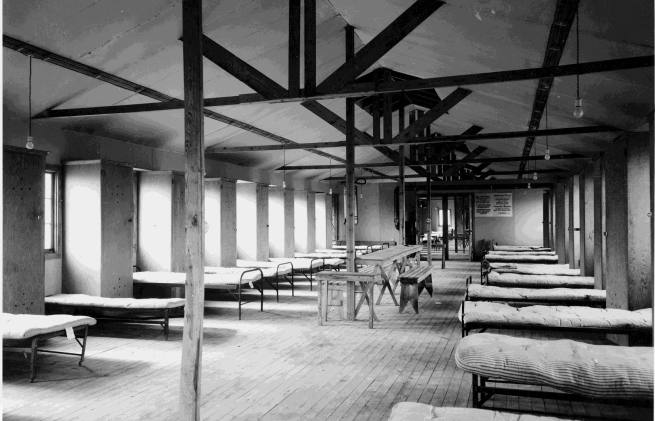
Inside Temporary Barracks with 95 Beds – Courtesy US Navy
TRANSPORTATION AND RAILROAD
Transportation was a problem for workers and for local people. Commercial buses were contracted to go 40 miles north of the Naval Base, and between Leonardtown to the Naval base. Materiel needed for construction was generally moved by truck across roads that were being widened to carry the traffic. Where construction was near the water, materiel was transported by boat.
Since the 1870’s the Pennsylvania Railroad System has been operating from Brandywine, MD to Mechanicsville with plans to continue on down to Pt. Lookout. However, the railroad was never completed. Realizing a need for improved transportation, the Navy contracted to extend the railroad from Mechanicsville to NAS Patuxent River. It was intended that this new extension would be primarily for Navy materiel and not for passengers. The railroad was completed in 1943 and was operated by the NAS Public Works Department. In 1952, the government railroad was extended 55 miles to Brandywine. The Navy railroad included 30 pieces of equipment, 3 diesel locomotives, and 3 railroad cranes. On average the train hauled 110 cars per week between NAS and Brandywine. In 1954 the NAS Patuxent River Railroad train left the NAS for Hollywood for the last time. The Government turned the operation over to the Pennsylvania Railroad who ran it until 1965. The Government declares the railroad excess property and the County purchases the railway right of way in 1970. A few years later the County government removes the rails and ties with the intent on creating a hiking trailing which as of 2018 is partially completed. [1]
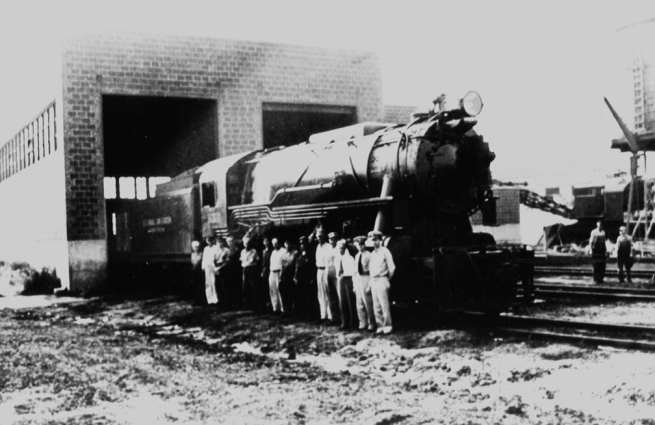
Railroad operated by Public Works Dept; Brandywine to Pax River 1944 – Courtesy US Navy
[1] History of St. Mary’s County by Regina Hammett page 412
Patuxent River Railroad – Courtesy US Navy
HANGAR CONSTRUCTION
Construction of the seven concrete hangars (109, 110, 111, 115, 305, and 306) at the Patuxent River Naval Air station were completed within 7 months. National Registry documents indicate that these concrete hangars were constructed using a patented process called post-tensioned thin shell concrete technology, also known as stressed-skin. The process included pouring cement over cables laid on the arched roof supported by massive movable forms. Before the cement dries, the cables are tensioned. Then the concrete is dry, and the massive forms are rolled to the next hangar section to repeat the process.
At the time these hangars were built they were the largest structure using this technique in the United States. These hangars have individually been nominated to the National Register of historic places. This technology was widely used after WWII as a result of its successful use by the navy building hangars such as these. [1]
[1] Historic Documentation Company, Portsmouth, RI; National Registry Nomination Projects: http://www.historicdoc.com/NR-1.htm
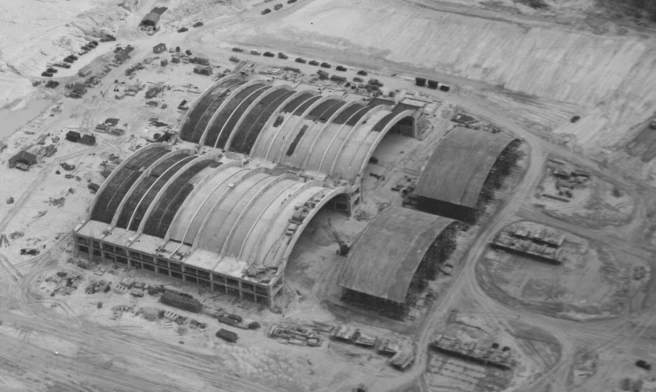
Hangar Construction: Thin-shell concrete system with movable forms on rails – Courtesy US Navy
SECURITY
On October 1942, 75 Marines arrived under the command of Major Harry E. Leland. In a show of esprit de corps he led his Marines from Gate 1 to the Marine barracks through mud up to the top of their boots. Station security started in November 1942 with Pinkerton Detectives manning the front gate. They were being paid by the contractors working on the base. In December 1942 the Marines had completed the task of fingerprinting all the civilian employees and handed out base passes. Through fingerprinting, it was found that some of the Pinkerton guards had criminal records as well as many in the civilian work force. From March 1943 through January 1944 the Marines made 2,204 arrests and got rid of the draft dodgers, felons, liquor smugglers, prostitutes, thieves, and gamblers and discontinued the civilian police force. The Marines were eventually supplemented by the U.S. Coast Guard to protect the external area around the base.[1]
The original name of the new Naval Air Station was Cedar Point. However, this name was very close to the Cherry Point NAS in North Carolina. To avoid confusion Cedar Point was changed to the Patuxent River Naval Air Station on June 4, 1942.
[1] History of St. Mary’s County by Regina Hammett of 1977 P. 415
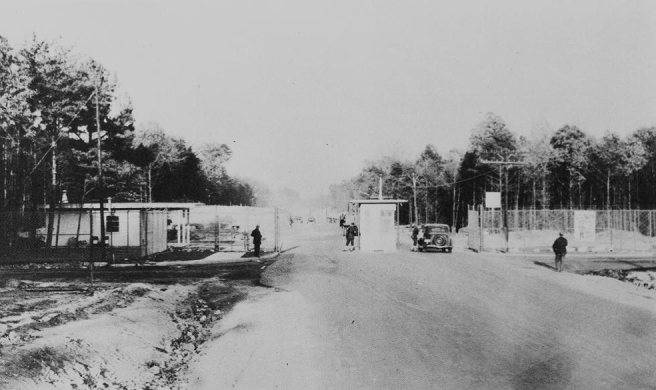
Main Gate House 1942 – Courtesy US Navy
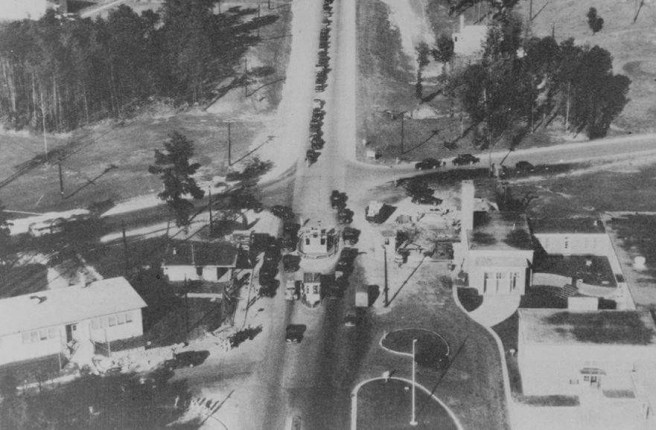
Main Gate Later 1940s – Courtesy US Navy
COMMISSIONING OF THE PATUXENT RIVER
NAVAL AIR STATION
On April 1, 1943, just one year from when the ground was broken, the Naval Air Station was commissioned. Rear Admiral John S. McCain, then chief of the Navy’s Bureau of Aeronautics said the establishment of the NAS Patuxent River is to provide aircraft, equipment, personnel, a physical location ……for the flight testing of experimental planes and equipment; the tactical test and development section, and the ground testing of any equipment or material coming under the cognizance of the Bureau”.[1] He further said that NAS Patuxent River “the most needed station in the Navy”.
Employment under Civil Service at the NAS was started in November 1942 and was under the Washington Navy Yard. It wasn’t until March 1st of 1943, that the payroll was established out of Patuxent River Naval Air Station. At the time of NAS commissioning there were 173 Civil Servants. By July 31, 1945 there were 2,414 Civil Servants at Pax.
Webster Field was established as an outlying field for NAS and is located on 773 acres of land that was acquired from the Jesuits on a peninsula called Priests Point on St. Inigoes Creek and the St. Mary’s River in St. Mary’s County. Webster Field was named after the late Capt. W. W. Webster whose naval career was closely associated with the testing of aircraft. Webster Field was ready for use on October 22, 1943.[2]
[1] Aer-E-15-AK NA83 CONF memo Chief Bureau of Aeronautics of 27 January 1943
[2] History of St. Mary’s County by Regina Hammett of 1977 P.415-6
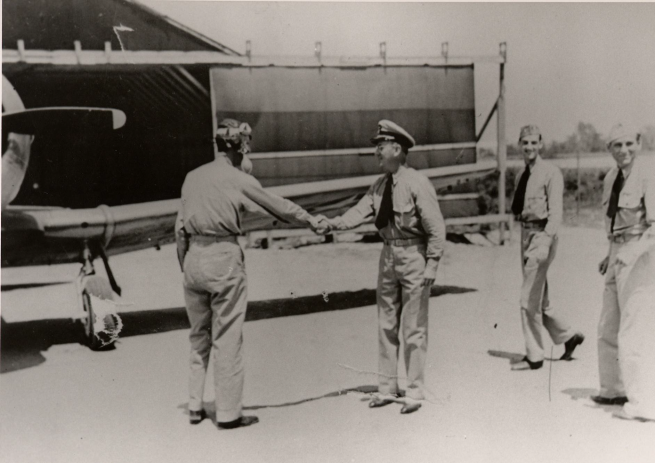
First Flight to NAS Patuxent River in 1943 – Courtesy US Navy
THE NAVAL AIR TEST CENTER ESTABLISHMENT
In the initial organization of the Naval Air Station, the Commanding Officer was in charge of administration of the station and the testing of airplanes. However, it was found that the administrative duties were over whelming that there wasn’t time to test airplane. On June 16, 1945 the Naval Air Test Center (NATC) was established and its sole function was the test and evaluation of airplanes and its components. The Commander of the Naval Air Station was responsible for the administration of personnel and maintenance of facilities. The Commander of the NATC was responsible for managing the composite organization of Armament Test, Tactical Test, Electronics Test, Service Test, and Test Facilities. Also, the Officer in Charge of Webster Field will report to Commander NATC. [1]
The Naval Test Pilot School was established in 1945 when the Navy’s Flight Test Group transferred from Anacostia, Washington DC to the Naval Air Station Patuxent River.
The establishment of the NATC and the Navy Test Pilot School was the start of decades of development and testing naval aircraft and integrated weapons systems to ensure the aircraft meets the needs of the fleet. In January 1992 the NATC was disestablished and the Patuxent River NAS received the Aircraft Division of the Naval Air Warfare Center (NAWCAD) in an effort to consolidate its technical capabilities and improve its products and services. Along with the Naval Test Wing Atlantic (NTWL) the combined mission was the development and improvement of weapons. Today the Naval Air Station Patuxent River has many tenant activities such as the Naval Air Systems Command, the U.S. Naval Test Pilot School, Air Test and Evaluation Squadron 1, Scientific Development Squadron 1, Air Test and Evaluation Squadron 20, Rotary Wing Test Squadron 21, and the Air Test and Evaluation Squadron 23. The NAS Patuxent River has become the center of excellence for the test and evaluation of aircraft systems.
[1] United States Naval Administration World War II, Deputy Chief of Naval Operations (air) Naval Air Test Center, Patuxent River, Maryland First Draft Narrative, prepared under the supervision of the Director of Naval History 1945. P 35
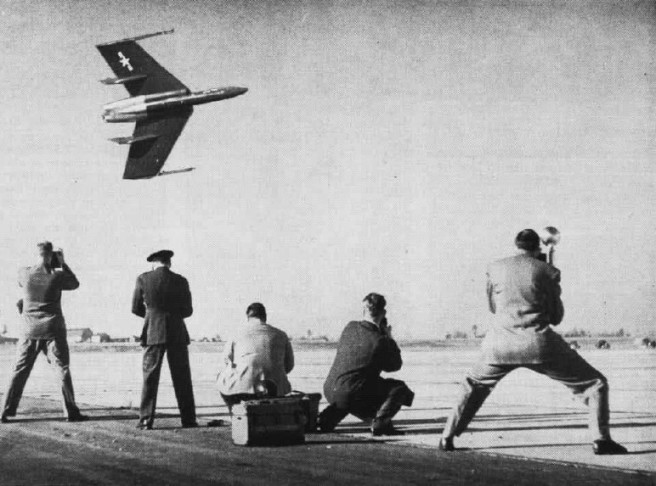
A Vought XF7U-1 Cutlass prototype being photographed by the press on 18 November 1948 at the Naval Air Test Center at Naval Air Station Patuxent River, Maryland (USA)[1]
[1] USN – U.S. Navy Naval Aviation News January 1949
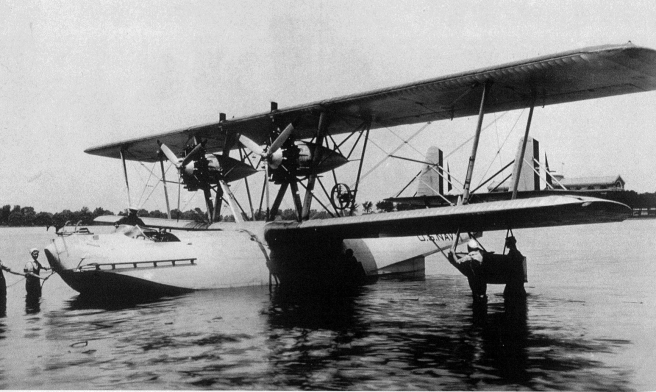
Consolidated P2Y Flying Boat at NAS Patuxent River – Courtesy US Navy
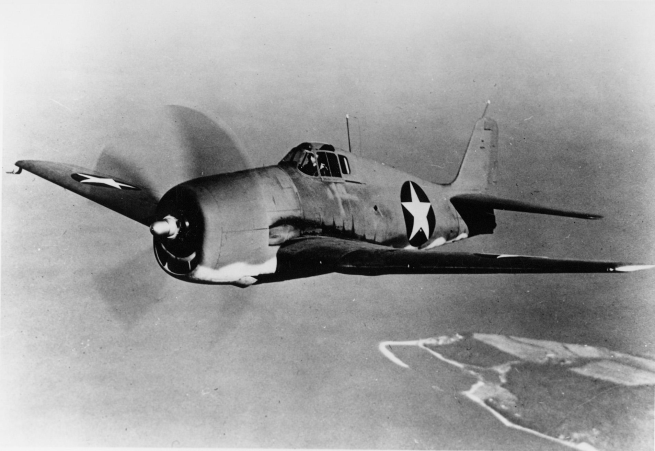
Grumman F6F Hellcat flies over Pax River – Courtesy US Navy
